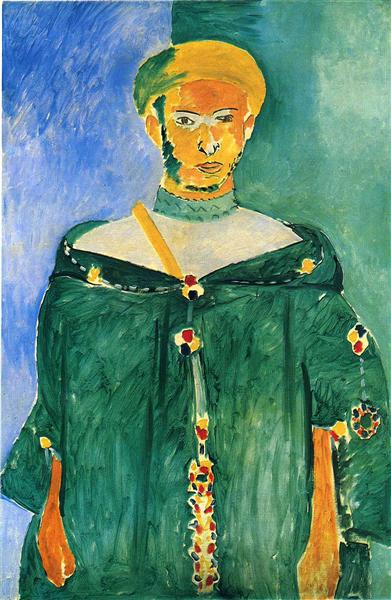Description
Henri Matisse, one of the foremost exponents of Fauvism, offers us in "Standing Moroccan in Green (Standing Riffian)" a deeply evocative and richly colored work. Painted in 1913, this 40x60 cm piece transports us to the exotic environment of Morocco, a place Matisse visited and which significantly influenced his work.
The painting features a dark-skinned individual, probably a Riffian from northern Morocco, dressed in an enveloping green djellaba. This figure stands against a monochromatic background that further emphasizes its imposing presence. The boldness of the Fauvists, with Matisse at the forefront, lay in their wild and non-naturalistic use of color, and in this work, green is omnipresent, endowing the protagonist with a mystical and striking air.
It is fascinating to observe how Matisse simplifies the forms in this representation without losing the essence of the subject. The contours, defined with bold and free strokes, exemplify the artist's transition towards a more abstract expression, far from anatomical accuracy and closer to the emotion and visual sensation evoked by the presented image. However, despite the formal simplification, there is a richness in the details of the Riffian's face, with deep eyes that seem to reflect experiences of past lives and an expression that combines serenity and strength.
The neutral background devoid of narrative elements allows the viewer to focus exclusively on the figure of the Riffian, granting him absolute prominence. Here, Matisse challenges us to confront the image without distractions, immersing us in the purity of his aesthetic approach. The juxtaposition between the man's green garment and the beige emptiness of the background creates an interesting visual tension, a contrast typical of Matisse's work.
It is known that Henri Matisse's stay in Morocco marked a significant turning point in his artistic career. Fascinated by the light and color of North Africa, Matisse found in the traditional clothing and the urban and natural environment of Morocco an inexhaustible source of inspiration. This influence is palpable in "Standing Moroccan in Green," where the traditional attire and the calm yet firm posture of the subject resonate with the authenticity and dignity of Moroccan culture.
An inevitable comparison for this work is "Zorah on the Terrace" also by Matisse, in which similarly, he uses high color contrasts and simplification of forms. Both works reveal the artist's fascination with people and their cultural environment, as well as his desire to capture the deepest essence of his subjects through a vivid palette and schematic forms.
In conclusion, "Standing Moroccan in Green (Standing Riffian)" is a celebration of Henri Matisse's mastery in manipulating color and form to create works that transcend mere figurative representation, evoking a deeper emotional and spiritual connection. This painting not only highlights the importance of the cultural context that inspired Matisse but also reflects the artist's continuous journey towards greater freedom in visual expression, consolidating his legacy as one of the most innovative painters of the 20th century.

